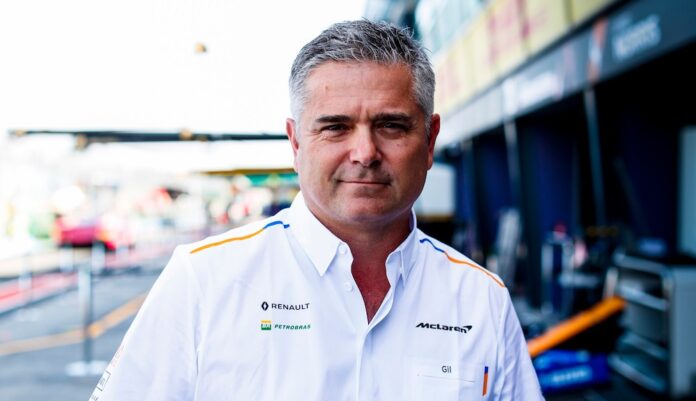Gil de Ferran, the holder of IndyCar’s fastest qualifying average at 241.428mph, the two-time CART IndyCar Series champion, and winner of the 2003 Indianapolis 500, has died at the age of 56. de Ferran is believed to have suffered a heart attack while participating at an automotive event in Florida.
His former team owner Derrick Walker spoke for the entire racing community after learning of his driver’s death.
“I’m just shocked,” Walker told RACER. “I’m sure it will be a shock to those who knew him and those who were his fans. He made an impression in this short life, that’s for sure. And he still had a lot of living left to do.”
The French-born Brazilian rose to prominence in the early 1990s during his pursuit of Formula 1. de Ferran’s first major accomplishment was earning the 1992 British Formula 3 championship while driving for Paul Stewart Racing, following which he graduated to the fierce Formula 3000 series — known today as Formula 2—and placed third in 1994 before earning an invitation from legendary team owner Jim Hall to sample a CART Indy car.
With no serious prospects to reach F1, de Ferran rerouted his career to America with the Hall/VDS Racing team in 1995 and spent the season learning oval racing while showing his natural road racing talent by placing second on the streets of Vancouver at the penultimate round and winning the season finale at Laguna Seca.
He’d turn Hall/VDS into a front-runner as a sophomore, elevating the one-car team to sixth in the championship in 1996 while using Honda power for the first time, and moved to Walker’s emerging team in 1997. His time with Walker, using the same Honda powerplant, is where de Ferran’s newfound skills as an oval racer placed him center stage among CART’s greatest drivers as seven podiums netted second in the championship.
The next two years wouldn’t be as kind as the team’s allegiance to Goodyear tires — at a time when Firestone’s rubber was the one to beat — meant the Walker program went backwards, but de Ferran did manage to author one of the most impressive road course victories of the CART era at Portland in 1999 when he held off Firestone-shod Juan Pablo Montoya and Dario Franchitti to claim the win.
“As hard as it is to remember him in the past tense, I think of him as the ultimate professional,” Walker said. “We went through some phases where we weren’t very competitive, and he didn’t throw his toys about and complain. He’d jump in to help try and solve the problems, whichever they were, and spent as much time with the engineers as was necessary to improve things.

de Ferran set the closed-course land speed record during CART qualifying at Fontana in 2000 with a lap of 241.428mph in the Team Penske Reynard 2KI Honda. His record still stands to this day. Motorsport Images
“His engineering ways helped them and in the cockpit, and made things better. He was such a good team guy, a team-oriented guy, and we all greatly respected him and enjoyed working with him. I feel so bad for his family.”
It was the call to join a revamped Team Penske in 2000 that allowed de Ferran’s true potential to be shown. Wielding the ‘Renske,’ the Penske-developed Reynard 2KI-Honda-Firestone, de Ferran was a rocket, winning twice and standing on seven podiums as his mastery of roads, streets, and big and small ovals demonstrated how complete a driver he’d become.
While facing the likes of Montoya, Franchitti, Alex Zanardi, Greg Moore, Al Unser Jr, Michael Andretti, Paul Tracy, Emerson Fittipaldi, and so many other greats since his arrival in CART, de Ferran proved he belonged in their club with the first championship, but he wasn’t done.
He’d go back-to-back with and secure a second title with two wins and eight podiums in 2001 as Penske returned to its former glory as CART’s top team. Together, Penske and de Ferran adapted in 2002 and 2003 as the organization moved to the Indy Racing League, and in his final open-wheel season, the de Ferran was the class of the field at the Indianapolis Motor Speedway, leading home teammate Helio Castroneves in a 1-2 with their GForce-Toyotas.
“I can’t even believe it,” said former rival Paul Tracy. “He knew how to have a good time away from the track and was very serious on it. If we ever had IndyCar’s equivalent of Alain Prost, it was Gil. He was so good technically. He told me once, ‘I’m not that good of a driver. I’m just really good at setting them up.’ And I was the opposite. He was a details guy. That’s probably why he was so well regarded after his IndyCar career, because he was so good at all details.”
Retiring at the end of the year, de Ferran spent time away from the sport before turning to management for a brief period as Honda’s sporting director for its F1 team. With his deep ties to the brand, he was awarded a contract to run a factory LMP2 program for Acura in the American Le Mans Series, and returned in the middle of the 2008 season as the owner/driver of the de Ferran Motorsports ARX-01b with a young Simon Pagenaud as his teammate.
In the ALMS, the mentor and mentee thrived as Pagenaud, whose open-wheel career stalled when Champ Car fell apart after 2007, found a kindred spirit in de Ferran, and the two would spend hours discussing every imaginable area of chassis, aerodynamic, and electronic optimization with the Acura. With Scott Dixon added in for the long ALMS rounds, the trio were in the thick of the fight against fellow Acura teams and factory efforts from Audi and Porsche.
The 2009 season gave de Ferran Motorsports its first opportunity to go for an ALMS championship, this time in the LMP1 class with the new Acura ARX-02a. Despite winning half of the races, dFM placed second in the standings, and with the downturn in the economy, Acura’s grand ALMS efforts were halted.

The ALMS added a new chapter to de Ferran’s post-CART career when he became owner/driver of the de Ferran Motorsports Acura ARX-02a LMP1 team, and mentor to a young Simon Pagenaud. Motorsport Images
With the end of his ALMS program in sight, de Ferran turned the final race into a farewell and thank you to Jim Hall by dressing the ARX-02a in white, the color of Hall’s renowned Chaparral sports cars, and organized a few tribute laps with Hall and Pagenaud in the LMP1 and the cars of yesteryear.
Blessed with an excellent crew and no series to call home, de Ferran partnered with Steve Luczo and Jay Penske in 2010 to form de Ferran Dragon Racing as an entrant in the IndyCar Series and made use of countryman Raphael Matos as their driver. Although the team was competitive, it did not have the commercial backing to continue, and by 2011 de Ferran was searching for his next stop in the sport.
He also dusted off his helmet in a final farewell to driving at the 2011 Gold Coast 600 V8 Supercars event, where he laughed and had fun thrashing a Ford Falcon around the Surfers Paradise circuit in Australia with the Tekno Autosports team.
Afterwards, stints with Honda and McLaren in advisory or managerial roles consumed the remainder of the decade and de Ferran also managed to submit a proposal for a new Indy Lights chassis early in the 2010s when IndyCar was looking to modernize its ageing fleet. His sage-like voice also became a mainstay in the media, where de Ferran joined RACER magazine as its Editor-at-Large and contributed defining opinions and thought-provoking pieces that opened dozens of issues.
His wicked sense of humor, coupled with a full embrace of self-deprecation and deep introspective ways made de Ferran a favorite character in every paddock.
Former ALMS president Scott Atherton, who also ran the GForce chassis business in Georgia for the late ALMS founder Don Panoz, recalls a time where de Ferran reinforced the special brand of humanity that was infused within the man.
“He was such an icon of the sport in his IndyCar days,” Atherton said. “And when he won the Indy 500 for Penske in the Panoz chassis, and this had never happened to me before, I’m at my desk one day, the phone rings, and it’s Gil. And he says, ‘I want to come down and buy lunch for all the guys in the factory.’ Wow! And I thought, ‘Okay, there is obviously going to be a PR angle to this.’ And he said, ‘No, no, if you could point me in the right direction to local caterer.’ And this was just him. It wasn’t a PR person that was reaching out. It was himself, individually.
“And he got on a plane, flew to Atlanta, rented a car, organized the lunch, walked into the building, and went around and shook the hands of everybody that was responsible for building that car that enabled him to win the 500 for Penske. He signed pictures and posed for pictures and could not have been more gracious, more genuine. And to this day… I don’t know, maybe there’s other examples where drivers have done that, but he’s the only one I know of to single-handedly organize and execute what he did that day. It left a lasting impression on all of us. And I the more I think about this, I’m just destroyed.”
Honda was among the first to pay tribute.
“All of us at Honda and HRC are deeply saddened by Gil de Ferran’s sudden passing,” said David Salters, president of HRC US. “Gil was a big part of the Honda racing family and CART heritage. He held a special place in our hearts.
“His accomplishments, championships and victories on the track are well-known. Listening to him recount his closed-course record run at Fontana raised the hair on the back of my neck, and does once again now. An extremely talented man and brilliant racer.
“He also played multiple, vital roles off-track for Honda over the years. But above all, he was a loving husband and father. Our thoughts are now with his family, friends, and many fans around the world.”
de Ferran is survived by his wife Angela and children Anna and Luke.



